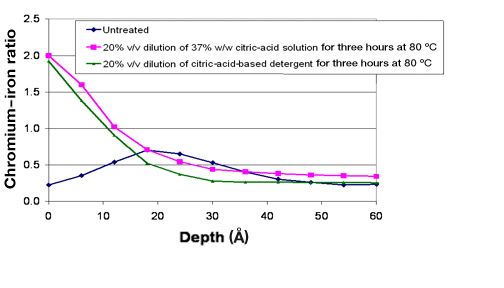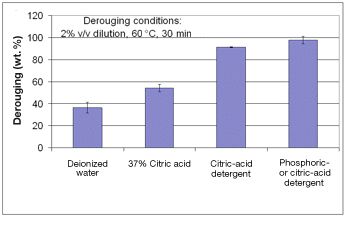Addressing Rouge in Biopharmaceutical Manufacturing Systems
Equipment and Processing Report
The author describes the types and sources of rouge and explains ways to prevent and mitigate this problem.
Stainless steel is the primary construction material for pharmaceutical and biopharmaceutical processing equipment. Prized for its ability to resist corrosion, stainless steel comes in hundreds of types and subtypes. Austenitic stainless steel is the most common type in these applications. It is nonhardened, nonmagnetic, and easily welded, and it resists heat and chemical sterilization and corrosion. The most common austenitic stainless steels are 304, 304L, 316, and 316L. “L” refers to low carbon content (i.e., 0.03% instead of 0.08%). The base metal of 304 and 316 stainless steels is iron (62–65%), which is combined with chromium (16–20%), nickel (8–14%), and other components such as carbon, silicon, and molybdenum (1).
Stainless steel becomes corrosion-resistant during a process called self-passivation, when the metal surface, which must be clean, comes into contact with oxygen to form a nonreactive chromium-enriched passive layer. In addition to naturally occurring passivation, chemicals such as nitric acid, phosphoric acid, citric acid, and formulated phosphoric acid–citric acid blends can passivate stainless steel (2–4).

The quality of the passive layer can be assessed through various methods, including X-ray photoelectron spectroscopy (XPS). XPS commonly helps scientists validate chemical treatments. Before passivation, operators rinse mechanically polished stainless-steel panels with isopropyl alcohol, high-purity water, acetone, and again with high purity water. After passivation treatment, operators remove the panels, rinse them with high-purity water, and allow them to air dry. Figure 1 shows the results of an XPS analysis (5, 6). The chromium–iron ratio at the surface of the untreated sample is approximately 0.25 Å, while that of the samples treated with formulated or commodity citric acid is approximately 2.0 Å.
Types and causes of rouge
Rouge is a corrosion product of stainless steel that ranges in color from reddish brown to blue or black. The general types of corrosion are galvanic, pitting, stress, intergranular, crevice, and microbe-induced. Rouge can be classified into the following three types (7, 8):
- Type I: Oxidized metal particles, generated by an external source through erosion or corrosion, that are deposited on downstream surfaces. This rouge generally is easy to wipe off, leaving the underlying stainless-steel surface intact (see Figure 2).
- Type II: Rougecaused by in situ oxidation, which generally adheres strongly and sometimes indicates underlying surface damage or pits.
- Type III: Black-oxide rouge generated by high temperatures or steam. The top layers of this rouge wipe off, but full removal often requires specific chemical treatment.

Rouge occurs in most biopharmaceutical facilities and often is associated purified-water systems, clean-steam systems, buffer-preparation tanks (especially sodium-chloride or glycine-solution preparations), filling lines, vial washers (which typically are cleaned with hot purified water), and steam sterilizers. Rouge results from exposure to highly aggressive environments such as purified-water or -steam systems, chloride or corrosive products, and high-temperature stress or erosion. Other factors that cause rouge are nonstainless-steel components or inserts, improper welding, surface defects, and inadequate cleaning or passivation.
Consistent procedures reduce downtime
Facilities should have procedures in place for cleaning, derouging, and passivating new equipment, as well as for periodically inspecting in-use water systems and process equipment. New equipment often arrives with particulates and oily residues from buffing, polishing, and lubricating compounds. These residues must be removed, and the chromium-enriched passive layer restored.
Qualified engineering or maintenance staff should inspect in-use equipment for rouge. Surface inspection will help determine whether the equipment needs to be derouged and passivated. If no program is in place, a semiannual inspection is recommended as a starting point.
Laboratory evaluation can help determine the best conditions (e.g., chemistry, concentration, time, and temperature) for removing specific types of rouge. A facility’s routine acid cleaner, when used at a higher concentration and for a longer time, may effectively remove the rouge and restore the passive layer.
Low-level preventive derouging and passivation
Formulated alkaline cleaners are effective at removing most biopharmaceutical-process residues from stainless-steel surfaces. The standard approach for routine cleaning is to remove organic residues with an alkaline cleaner and perform an acid rinse to remove inorganic residues and neutralize the alkaline cleaner. Although this acid rinse is performed at a lower concentration and for less time than during derouging and passivation, it also can be an effective method for removing rouge and enhancing the passive layer (see sidebar, “The general procedure for derouging and passivation of 304 and 316 stainless-steel surfaces.”) (9).
The author generated laboratory rouge by suspending a preweighed 304 stainless-steel coupon and mild steel coupon in a 1% sodium-chloride solution while mixing for one week. The laboratory-generated rouged coupons were then treated with water, citric acid, formulated citric acid, or phosphoric-acid detergent at 60 °C for 30 min. The results, shown in Figure 3, indicate that low-level concentration and temperature conditions can remove rouge.

A low-concentration acid rinse after an alkaline wash step has potential benefits for regular preventive maintenance, derouging, and passivation. Compared with removing the equipment from the production line completely to deal with rouge buildup, a low-level clean-in-place approach can save time, cost, and labor in the long run. In addition, preventive-maintenance programs that include routine inspection of equipment surfaces and piping, and specific derouging and passivation procedures, can reduce costly equipment downtime significantly.
References
- M.M. Gonzalez, Pharm. Eng.21 (5), 48–63 (2001).
- ASME, “Nonmandatory Appendix E: Passivation Procedure Qualification,” in BPE – 2009 Bioprocessing Equipment (ASME, New York, 2009), pp. 185–194.
- ASTM, A 967 – 99, Standard Specification for Chemical Treatments for Stainless Steel Parts (ASTM, West Conshohocken, PA, 2001), pp. 1–6.
- ASTM, A 380 – 96, Standard Practice for Cleaning, Descaling, and Passivation of Stainless Steel Parts, Equipment, and Systems (ASTM, West Conshohocken, PA, 1996), pp. 1–12.
- STERIS, “Lab Report 410-300-3308, The Effect of ProKlenz TWO on Passivation of 316 Stainless Steel,” (STERIS, Mentor, OH, 2009).
- P. Lopolito, INTERPHEX Puerto Rico 2010 (San Juan, Puerto Rico, 2010).
- R.E. Avery and R.K. Raney, Eur. J. Parenter. Pharm. Serv.13 (1), 21–24 (2008).
- J.C. Tverberg and J.A. Ledden, Proceedings of Tube 2000 (Dusseldorf, 2000).
- STERIS, “Lab Report 410-300-3313, Laboratory Derouging of Simulated Rouge Using ProKlenz TWO,” (STERIS, Mentor, OH, 2009).
Paul Lopolito is a technical services specialist at STERIS, Mentor, OH, [email protected].
Drug Solutions Podcast: A Closer Look at mRNA in Oncology and Vaccines
April 30th 2024In this episode fo the Drug Solutions Podcast, etherna’s vice-president of Technology and Innovation, Stefaan De Koker, discusses the merits and challenges of using mRNA as the foundation for therapeutics in oncology as well as for vaccines.